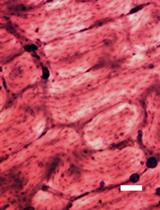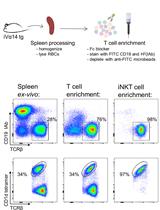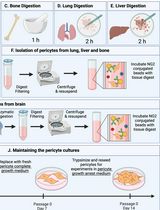- EN - English
- CN - 中文
Human Dendritic Cell Subset Isolation by Magnetic Bead Sorting: A Protocol to Efficiently Obtain Pure Populations
通过磁珠分选法分离人树突状细胞亚群:一种有效获得纯群体的方案
发布: 2023年10月20日第13卷第20期 DOI: 10.21769/BioProtoc.4851 浏览次数: 1895
评审: Chiara AmbrogioWendy Leanne Hempstock
Abstract
Dendritic cells have been investigated for cell-based immunotherapy for various applications. The low abundance of dendritic cells in blood hampers their clinical application, resulting in the use of monocyte-derived dendritic cells as an alternative cell type. Limited knowledge is available regarding blood-circulating human dendritic cells, which can be divided into three subsets: type 2 conventional dendritic cells, type 1 conventional dendritic cells, and plasmacytoid dendritic cells. These subsets exhibit unique and desirable features for dendritic cell-based therapies. To enable efficient and reliable human research on dendritic cell subsets, we developed an efficient isolation protocol for the three human dendritic cell subsets, resulting in pure populations. The sequential steps include peripheral blood mononuclear cell isolation, magnetic-microbead lineage depletion (CD14, CD56, CD3, and CD19), and individual magnetic-microbead isolation of the three human dendritic cell subsets.
Graphical overview

Scheme of the dendritic cell (DC) isolation protocol. Starting material for this process is human blood (buffy coat or aphaeresis). From that, peripheral blood mononuclear cells (PBMCs) are isolated by using ficoll gradient centrifugation. Then, an enrichment for DCs is performed using semi-automated equipment. From the enriched fraction, DC subsets are obtained by magnetic cell sorting.
Background
During the past decades, dendritic cells (DCs) have been investigated for their ability to initiate antigen-specific immune responses in vivo. DC-based immunotherapies have been developed or are under investigation for the treatment of various malignancies such as cancer (Gonzalez et al., 2018), autoimmune disorders such as rheumatoid arthritis, or multiple sclerosis (Collin and Bigley, 2018). Most of the current DC knowledge is from the human DC model, monocyte-derived DCs (moDCs), which have a very high purity and can be generated in significant numbers from peripheral blood mononuclear cells (PBMCs).
Recently, attention shifted towards the utilization of the three human DC subsets circulating in blood, due to their unique and distinct functions compared with moDCs (Wang et al., 2020). Blood-circulating human DCs can be broadly divided into plasmacytoid DCs (pDCs) and conventional DCs (cDCs). cDCs are highly specialized in antigen uptake, processing, and (cross-)presenting of antigens to naïve T cells, which is a crucial step for initiating immune responses. cDCs can be subdivided into type 1 (cDC1s) and type 2 (cDC2s). In humans, cDC1s express CD141 (BDCA-3), cDC2s express CD1c (BDCA-1), and pDCs express CD123 (BDCA-2). Each DC subset presents a unique function; for example, cDC1s can potently take up apoptotic cells, cross-present externally derived antigens, and activate cytotoxic lymphocytes (Schreibelt et al., 2012). These features place cDC1s in the center of interest for mounting anti-tumor immune responses. Thus, it is necessary to investigate the phenotypical and functional differences between human DC subsets in depth, with the goal of improving DC-based therapies.
Unfortunately, investigating the human DC subsets is a rather tedious task, mainly due to their scarcity in PBMCs, ranging from < 0.2% of PBMCs in the case of cDC2s and pDCs to < 0.08% of PBMCs in the case of cDC1s (van Beek et al., 2020). In addition, currently available human DC isolation protocols result in varying levels of cell impurity or cross-contamination with other human DC subsets. Contaminating cells present in DC cultures can greatly influence the phenotypical and functional outcome of DC research (van Beek et al., 2020), hampering the elucidation of the role of individual human DC subsets.
We have developed a protocol to isolate highly pure populations of human DC subsets starting from PBMCs. Using the protocol described here, DC subsets can be isolated with higher purity and yield compared with currently available options such as cell sorting or magnetic-microbead kits without the lineage depletion step. The protocol consists of multiple steps including depletion of monocytes (CD14+), B cells (CD19+), T cells (CD3+), and NK cells (CD56+) from PBMCs with magnetic microbeads, followed by DC isolation using magnetic microbeads specific for each DC subset: cDC2s (CD1c+), cDC1s (CD141+), and pDCs (CD304+). We present the protocol with the use of semi-automated equipment (MultiMACS Cell24 Separator Plus, Miltenyi Biotec) that significantly reduces the time needed for the DC isolation process.
Materials and reagents
Beads and items for cell separation
Anti-CD3 microbeads (Miltenyi Biotec, catalog number: 130-050-101)
Anti-CD14 microbeads (Miltenyi Biotec, catalog number: 130-050-201)
Anti-CD19 microbeads (Miltenyi Biotec, catalog number: 130-097-055)
FcR blocking reagent (Miltenyi Biotec, catalog number: 130-059-901)
Anti-CD56 microbeads (Miltenyi Biotec, catalog number: 130-050-401)
Anti-CD1c biotin (Miltenyi Biotec, catalog number: 130-119-475)
Anti-biotin microbeads (Miltenyi Biotec, catalog number: 130-090-485)
Anti-CD141 microbeads (Miltenyi Biotec, catalog number: 130-090-532)
LD columns (Miltenyi Biotec, catalog number: 130-042-901)
MS columns (Miltenyi Biotec, catalog number: 130-042-201)
LS columns (Miltenyi Biotec, catalog number: 130-042-401)
Multi-24 column blocks (8×) (Miltenyi Biotec, catalog number: 130-095-691)
Single-well deep-well plates (Miltenyi Biotec, catalog number: 130-114-966)
Buffers and media
Human albumin (Sigma-Aldrich, catalog number: H0900000)
PBS (Life Technologies, catalog number: 14190-094)
Human serum (Sigma-Aldrich, catalog number: H4522-100ML)
X-VIVO15 hematopoietic cell culture medium (Life Technologies, catalog number: BE02-060Q)
UltraPureTM 0.5 M EDTA, pH 8.0 (Thermo Fisher, catalog number: 15575020)
Ammonium chloride (Sigma-Aldrich, catalog number: 213330)
Potassium bicarbonate (Sigma-Aldrich, catalog number: 237205)
Disodium EDTA (Sigma-Aldrich, catalog number: E4884)
Bovine serum albumin (Thermo Fisher, catalog number: 23209)
Sodium azide (Merck, catalog number: RTC0000068- 1L)
Trypan Blue (Sigma-Aldrich, catalog number: T6146-25G)
Diluting buffer (see Recipes)
ACK lysis buffer (see Recipes)
Washing buffer (see Recipes)
PBA (see Recipes)
Antibodies
Anti-CD20 FITC (BD Biosciences, catalog number: 345792)
Anti-CD14 PerCP (BioLegend, catalog number: 325632)
Anti-CD141 APC (Miltenyi Biotec, catalog number: 130-090-907)
Anti-CD1c PE (Miltenyi Biotec, catalog number: 130-113-864)
Anti-CD123 APC (BD Biosciences, catalog number: 560087)
Anti-BDCA2 PE (Miltenyi Biotec, catalog number: 130-097-929)
Materials
Ficoll lymphoprep (VWR, catalog number: CLUT1114547)
Tuerk’s solution for leukocyte counting (Merck, catalog number: 1092770100)
Tubes (Stem Cell Technologies, catalog number: 100-0088)
50 mL tubes (Corning, catalog number: 430828)
96-well V-bottomed plate (Thermo Fisher, catalog number: 277143)
Microbeads, antibodies, X-VIVO15 hematopoietic cell culture medium, washing buffer, and PBA were stored at 4 °C. Diluting buffer, PBS, and ACK lysis buffer were stored at RT.
Note: Products and equipment from other vendors (when available) can also be used.
Equipment
MultiMACS Cell24 Separator Plus (Miltenyi Biotec, catalog number: 130-098-637)
QuadroMACS Separator (Miltenyi Biotec, catalog number: 130-090-976)
OctoMACS Separator (Miltenyi Biotec, catalog number: 130-042-109)
FACSVerse (Becton Dickinson)
Note: This FACS has three lasers and eight colors (four in the blue laser, two in the red laser, and two in the violet laser).
Centrifuge (Hettich centrifuge, model: rotanta 460R)
Cell counting chamber (Thermo Fisher, catalog number: C10228)
Shaker (Thermo Fisher, SHKE4000-7: MaxQ)
Software
FACS verse software BD (BD FACSVerseTM Systems)
FlowJo (FlowJoTM v10.8)
Procedure
文章信息
版权信息
© 2023 The Author(s); This is an open access article under the CC BY-NC license (https://creativecommons.org/licenses/by-nc/4.0/).
如何引用
Flórez-Grau, G., Cuenca Escalona, J., Lacasta-Mambo, H., Roelofs, D., Bödder, J., Beuk, R., Schreibelt, G. and de Vries, I. J. M. (2023). Human Dendritic Cell Subset Isolation by Magnetic Bead Sorting: A Protocol to Efficiently Obtain Pure Populations. Bio-protocol 13(20): e4851. DOI: 10.21769/BioProtoc.4851.
分类
免疫学 > 免疫细胞分离 > 抗原递呈细胞
细胞生物学 > 细胞分离和培养 > 细胞分离 > 免疫磁珠
您对这篇实验方法有问题吗?
在此处发布您的问题,我们将邀请本文作者来回答。同时,我们会将您的问题发布到Bio-protocol Exchange,以便寻求社区成员的帮助。
提问指南
+ 问题描述
写下详细的问题描述,包括所有有助于他人回答您问题的信息(例如实验过程、条件和相关图像等)。
Share
Bluesky
X
Copy link












